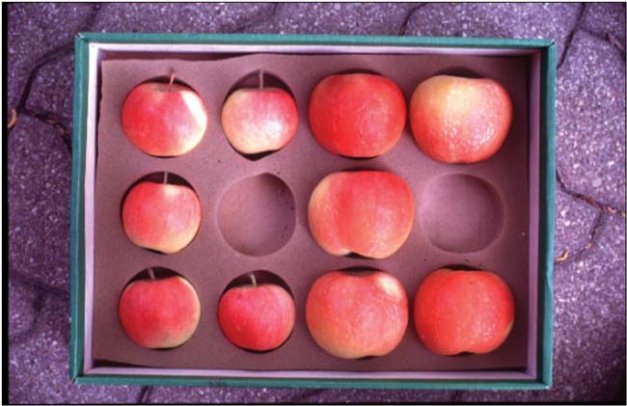
Grand Gala apples (right) weigh about 50 percent more and are 15 percent bigger in diameter than other Gala strains.
That Gala apple sport called Grand Gala apparently deserves its name, and researchers at Purdue University have found out why.
It’s because of a process called endoreduplication—never before found in apples—in which cells in the fruit carry out an unusual cell division, doubling the DNA in the nucleus but not dividing the cell and increasing cell numbers. The apple changes from a diploid to a polyploid in chromosome number—but just in the fruit, not in the leaves.
A few other apple varieties are triploids, and one, Golden Delicious, is a tetraploid, but the Grand Gala apple cells contain up to 8, or even 16, copies of the same chromosome.
The cells become larger. Not only does the apple become about 50 percent larger, but several other fundamental changes occur as well.
“The fruit is not only bigger, it’s sweeter and crisper in texture,” said Peter Hirst, Purdue University horticulturist in West Lafayette, Indiana. He decided to investigate the apple and carried out studies with doctoral student Anish Malladi, who has since been appointed to a horticultural position at University of Georgia.
Is this a heritable trait that can be transferred to other varieties by breeding?
“I don’t know,” Hirst said. “But I’ve got seeds in the refrigerator right now. Check back in a few years.”
Size
The Royal Gala, which originated in New Zealand, is known to mutate easily, but most of the mutations are for red color, Hirst said. There are now more than 20 different strains of Gala being marketed.
Recently, there have been at least two mutations for fruit size, mutations that could be highly desirable because Gala is a small apple. Hirst decided to study one of the new sports. “It wasn’t just curiosity,” he said. “Fruit size is a major driver of profitability for apple growers, who can get twice as much for a large apple as a small one.”
Unfortunately, the Grand Gala does not have the uniform shape of other Gala strains, and Hirst doesn’t think it will be able to overcome its misshapen appearance in the wholesale market. But at direct farm markets, where consumers have learned to shop with their taste buds and not just their eyes, the apple will probably catch on, Hirst believes. He really likes the apple—its sweetness and its Honeycrisplike crunchy texture. “The eating sensation is different—a whole lot better,” he said.
Hirst said that these large sports arose as spontaneous bud mutations. Big Red Gala was discovered by Ed Fackler as a limb mutation of the standard Kidd’s D-8 Gala at his farm in southern Indiana, while Grand Gala was discovered by Charles McSpadden in Tennessee, as a mutation of Royal Gala.
Both of these have since been patented and licensed—Big Red Gala to ProTree Nurseries in California and Grand Gala to Stark Bro’s Nurseries in Missouri.
In the orchard, there is very little difference between Big Red Gala and Grand Gala, Hirst said, but he’s not sure whether the two sports achieved their traits with the same genetic mutations.
“The reason Big Red Gala and Grand Gala have larger fruit is not due to more cells, but due to larger cells,” Hirst wrote a year ago in the Indiana grower newsletter Facts for Fancy Fruit. “The cells also have larger nuclei with more DNA, but that’s another, more complicated, story. The fruit also have higher soluble solids (sugar) concentrations. My impression is that the large-fruited strains mature a little earlier. I don’t have any comparisons for storage life, but suspect the larger strains may not keep quite as well.”
Before a grower orders thousands of trees, Hirst offers words of caution.
“Some of the fruit of these large strains tends to be less regular in shape than other Gala strains. The fruit is rounder and less conical. The trees seem to have less apical dominance and the leader wants to flop over, but this can be managed with attention to staking. Trees are shorter, and this may be because of the increased bending caused by the larger fruit.
“Overall, Big Red Gala and Grand Gala tend to be crisper and sweeter than other Gala strains. The fruit are much larger than other Galas, but the shape is not as regular. These varieties offer promise for retail growers, but the irregular shape probably disqualifies them for wholesale growers.”
Though the fruit is larger overall—about 15 percent larger in diameter and 50 percent in weight—the core is not larger, so there is more edible fruit volume in the Grand Gala, Hirst said. The size difference begins to show up before fruit set. The developing apple has a larger stem and seems to be able to draw more carbohydrate. “There seems to be a better path from leaves to fruit, more pulling power in the fruit,” Hirst said.
The process of endoreduplication has been found in other plants, including tomatoes and soybeans, and in tadpoles, but not in apples. Hirst and Malladi’s findings are reported in detail in the May issue of the Journal of Experimental Botany, and the paper can be downloaded from its Web site at http://jxb.oxfordjournals.org.

Leave A Comment